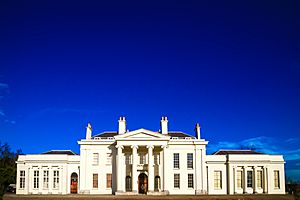John Comyns facts for kids
Sir John Comyns (born around 1667 – died November 1, 1740) was an important English judge and a Member of Parliament. He lived in a place called Writtle in Essex, England.
Contents
Early Life and Education
John Comyns was the oldest son of William Comyns, who was also a lawyer. His mother was Elizabeth Rudd. John went to Felsted School and then studied at Queens' College, Cambridge, which are both well-known schools.
Career as a Judge and Politician
John Comyns had a very successful career in law and politics.
Becoming a Lawyer
He became a member of Lincoln's Inn, which is one of the places where lawyers are trained in London. He officially became a lawyer, or was "called to the bar," in 1690. This meant he could argue cases in court.
Serving in Parliament
In 1701, Sir John became a Member of Parliament for the town of Maldon. He represented Maldon for many years, a total of 17 years between 1701 and 1726.
Sometimes, when he was elected, his opponents would complain. They said that people had been bribed or that the election was not fair. However, most of the time, these complaints didn't stop him from being elected. Only once, in 1715, was his election cancelled because he was accused of not taking an important oath.
Rising Through the Courts
As his career progressed, Sir John Comyns took on more important roles in the legal system:
- In 1705, he became a serjeant-at-law, which was a senior type of lawyer.
- In 1726, he was made a Baron of the Exchequer and was also knighted, so he became "Sir John." A Baron of the Exchequer was a judge in a special court that dealt with money matters for the King.
- In 1736, he became a Justice of Common Pleas. This court handled disagreements between ordinary people.
- Finally, in 1738, he reached one of the highest legal positions: Chief Baron of the Exchequer.
Important Books He Wrote
Sir John Comyns was not only a judge but also an author of important legal books.
One of his famous works is called Reports of Cases adjudged in the Courts of King's Bench, Common Pleas, and Exchequer. This book recorded decisions made in the courts. It was originally written in "law French," which was a special language used by lawyers back then. His nephew later translated it into English.
He also wrote A Digest of the Laws of England. This book was like a summary or guide to all the laws in England. It was also first written in law French and then translated. These books were very helpful for other lawyers and judges.
Hylands House: His Home
Around 1726, Sir John Comyns bought a piece of land in Writtle. He then decided to build a grand new home there, fitting for someone of his important position.
The house, named Hylands House, was finished in 1730. It was an elegant, two-story building made of red brick, built in the popular Queen Anne style architecture of the time. The gardens around the house were designed in a very neat and formal way. Today, Hylands House is a Grade II* listed building, which means it's a very important historical building that is protected.
His Family Life
Sir John Comyns was married three times. His first wife was Anne Gurdon, his second was Elizabeth Courthorpe, and his third was Anne Wilbraham. He did not have any children of his own. After he passed away and his widow died, Hylands House went to his nephew, who was also named John Comyns.
See also
- William Chaloner


